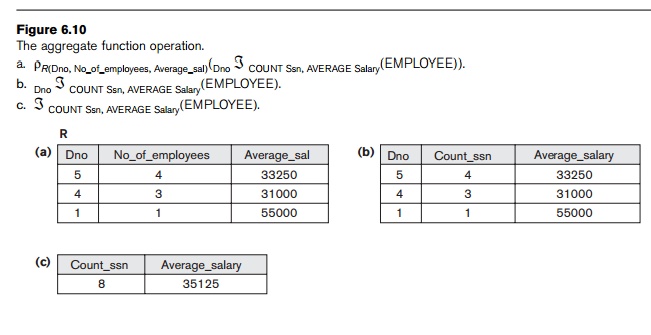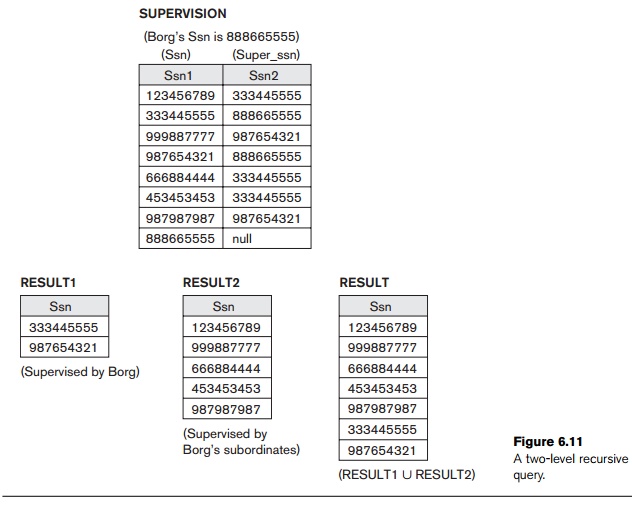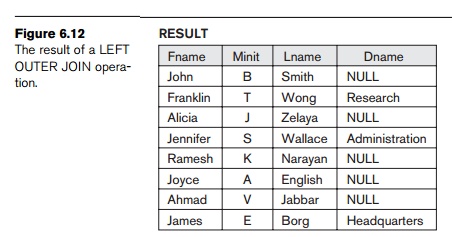Chapter: Fundamentals of Database Systems : The Relational Data Model and SQL : The Relational Algebra and Relational Calculus
Additional Relational Operations
Additional Relational Operations
Some common database requests—which are needed in commercial
applications for RDBMSs—cannot be performed with the original relational
algebra operations described in Sections 6.1 through 6.3. In this section we
define additional operations to express these requests. These operations
enhance the expressive power of the original relational algebra.
1. Generalized
Projection
The
generalized projection operation extends the projection operation by allowing
functions of attributes to be included in the projection list. The generalized
form can be expressed as:

where F1, F2, ..., Fn
are functions over the attributes in relation R and may involve arithmetic operations and constant values. This
operation is helpful when develop-ing reports where computed values have to be
produced in the columns of a query result.
As an
example, consider the relation
EMPLOYEE (Ssn, Salary, Deduction,
Years_service)
A report
may be required to show
Net Salary = Salary – Deduction,
Bonus = 2000 * Years_service, and
Tax = 0.25 * Salary.
Then a
generalized projection combined with renaming may be used as follows:
REPORT ← ρ(Ssn, Net_salary, Bonus, Tax)(πSsn, Salary – Deduction, 2000 * Years_service,
* Salary(EMPLOYEE)).
2. Aggregate
Functions and Grouping
Another
type of request that cannot be expressed in the basic relational algebra is to
specify mathematical aggregate functions
on collections of values from the data-base. Examples of such functions include
retrieving the average or total salary of all employees or the total number of
employee tuples. These functions are used in simple statistical queries that
summarize information from the database tuples. Common functions applied to
collections of numeric values include SUM, AVERAGE, MAXIMUM, and
MINIMUM. The COUNT function is used for counting tuples or values.
Another
common type of request involves grouping the tuples in a relation by the value
of some of their attributes and then applying an aggregate function independently to each group. An example
would be to group EMPLOYEE tuples by Dno, so that
each group includes the tuples for employees working in the same department. We can then list each
Dno value along with, say, the
average salary of employees within the department, or the number of employees
who work in the department.
We can
define an AGGREGATE FUNCTION
operation, using the symbol ℑ
(pronounced script F)7,
to specify these types of requests as follows:
<grouping
attributes> ℑ
<function list> (R)
where
<grouping attributes> is a list of attributes of the relation specified
in R, and <function list> is a
list of (<function> <attribute>) pairs. In each such pair,
<function> is one of the allowed functions—such as SUM, AVERAGE, MAXIMUM, MINIMUM, COUNT—and <attribute> is an attribute of the relation specified by R. The
resulting relation has the grouping attributes plus one attribute for each
element in the function list. For example, to retrieve each department number,
the number of employees in the department, and their average salary, while
renaming the resulting attributes as indicated below, we write:
ρR(Dno, No_of_employees, Average_sal)(Dno ℑ COUNT Ssn, AVERAGE Salary (EMPLOYEE))
The
result of this operation on the EMPLOYEE relation
of Figure 3.6 is shown in Figure 6.10(a).
In the
above example, we specified a list of attribute names—between parentheses in
the RENAME operation—for the resulting
relation R. If no renaming is
applied, then the attributes of the resulting relation that correspond to the
function list will each be the concatenation of the function name with the
attribute name in the form <function>_<attribute>.8 For
example, Figure 6.10(b) shows the result of the fol-lowing operation:
Dno ℑ COUNT Ssn, AVERAGE Salary(EMPLOYEE)
If no
grouping attributes are specified, the functions are applied to all the tuples in the relation, so the
resulting relation has a single tuple
only. For example, Figure 6.10(c) shows the result of the following operation:
ℑ
COUNT Ssn, AVERAGE Salary(EMPLOYEE)
It is
important to note that, in general, duplicates are not eliminated when an aggregate function is applied; this way,
the normal interpretation of functions such as

SUM and AVERAGE is computed.
It is
worth emphasizing that the result of applying an aggregate function is a
relation, not a scalar number—even if it has a single value. This makes the
relational algebra a closed mathematical system.
3. Recursive Closure
Operations
Another
type of operation that, in general, cannot be specified in the basic original
relational algebra is recursive closure.
This operation is applied to a recursive
relationship between tuples of the same type, such as the relationship
between an employee and a
supervisor. This relationship is described by the foreign key Super_ssn of the EMPLOYEE relation in Figures 3.5 and 3.6,
and it relates each employee tuple (in the role of supervisee) to another
employee tuple (in the role of supervisor). An example of a recursive operation
is to retrieve all supervisees of an employee e at all levels—that is, all employees e directly supervised by e,
all employees e ℑ directly supervised by each employee e , all employees e directly supervised by each employee e , and so on.
It is
relatively straightforward in the relational algebra to specify all employees
supervised by e at a specific level
by joining the table with itself one or more times. However, it is difficult to
specify all supervisees at all
levels. For example, to specify the Ssns of all
employees e directly supervised—at level one—by the employee e whose name is ‘James Borg’ (see Figure
3.6), we can apply the following operation:
BORG_SSN ← πSsn(σFname=‘James’ AND Lname=‘Borg’(EMPLOYEE))
SUPERVISION(Ssn1, Ssn2) ← πSsn,Super_ssn(EMPLOYEE)
RESULT1(Ssn) ← πSsn1(SUPERVISION ![]() Ssn2=SsnBORG_SSN)
Ssn2=SsnBORG_SSN)
To
retrieve all employees supervised by Borg at level 2—that is, all employees e supervised by some employee e who is directly supervised by Borg—we
can apply another JOIN to the
result of the first query, as follows:
RESULT2(Ssn) ← πSsn1(SUPERVISION ![]() Ssn2=SsnRESULT1)
Ssn2=SsnRESULT1)
To get
both sets of employees supervised at levels 1 and 2 by ‘James Borg’, we can apply
the UNION operation to the two results, as follows:
RESULT ← RESULT2 ∪ RESULT1
The
results of these queries are illustrated in Figure 6.11. Although it is
possible to retrieve employees at each level and then take their UNION, we cannot, in general, specify
a query such as “retrieve the supervisees of ‘James Borg’ at all levels”
without utilizing a looping mechanism unless we know the maximum number of
levels. An operation called the transitive closure of relations has been proposed to compute the
recursive relationship as far as the recursion proceeds.

4. OUTER JOIN Operations
Next, we
discuss some additional extensions to the JOIN
operation that are necessary to specify certain types of queries. The JOIN operations described earlier
match tuples that satisfy the join condition. For example, for a NATURAL JOIN operation R * S, only
tuples from R that have matching
tuples in S—and vice versa—appear in the result. Hence, tuples without a matching (or related) tuple are eliminated from the JOIN result. Tuples with NULL values in the join attributes
are also eliminated. This type of join, where tuples with no match are
eliminated, is known as an inner join. The join operations we described
earlier in Section 6.3 are all inner joins. This amounts to the loss of information if the user wants the result of
the JOIN to include all the tuples in one
or more of the component relations.
A set of
operations, called outer joins, were
developed for the case where the user wants to keep all the tuples in R, or all those in S, or all those in both relations in the result of the JOIN, regardless of whether or not
they have matching tuples in the other relation. This satisfies the need of
queries in which tuples from two tables are to be combined by matching
corresponding rows, but without losing any tuples for lack of matching values.
For example, suppose that we want a list of all employee names as well as the
name of the departments they manage if
they happen to manage a department;
if they do not manage one, we can indicate it with a NULL value. We can apply an operation LEFT
OUTER JOIN, denoted by ![]() , to retrieve the result as follows:
, to retrieve the result as follows:
TEMP ← (EMPLOYEE ![]() Ssn=Mgr_ssnDEPARTMENT)
Ssn=Mgr_ssnDEPARTMENT)
RESULT
← πFname, Minit, Lname, Dname(TEMP)
The LEFT OUTER JOIN operation keeps every tuple in
the first, or left, relation R in R ![]() S; if no matching tuple is
found in S, then the attributes of S in the join result are filled or padded with NULL values.
The result of these operations is shown in Figure 6.12.
S; if no matching tuple is
found in S, then the attributes of S in the join result are filled or padded with NULL values.
The result of these operations is shown in Figure 6.12.
A similar
operation, RIGHT OUTER JOIN, denoted
by ![]() , keeps every tuple in the second, or right, relation S in the result of R
, keeps every tuple in the second, or right, relation S in the result of R ![]() S. A third operation, FULL OUTER JOIN, denoted
by
S. A third operation, FULL OUTER JOIN, denoted
by ![]() , keeps all tuples in both the left and the
right relations when no matching tuples are found, padding them with NULL values as needed. The three
outer join operations are part of the SQL2 standard (see Section 5.1.6). These
operations were provided later as an extension of relational algebra in
response to the typical need in business applications to show related
information from multiple tables exhaustively. Sometimes a complete reporting
of data from multiple tables is required whether or not there are matching
values.
, keeps all tuples in both the left and the
right relations when no matching tuples are found, padding them with NULL values as needed. The three
outer join operations are part of the SQL2 standard (see Section 5.1.6). These
operations were provided later as an extension of relational algebra in
response to the typical need in business applications to show related
information from multiple tables exhaustively. Sometimes a complete reporting
of data from multiple tables is required whether or not there are matching
values.
5. The OUTER UNION
Operation
The OUTER UNION operation was developed to take
the union of tuples from two relations that have some common attributes, but
are not union (type) compatible. This
operation will take the UNION of
tuples in two relations R(X, Y
) and S(X, Z) that are partially compatible, meaning that only
some of their attributes, say X, are
union compatible. The attributes that are union compatible are represented only
once in the result, and those attributes that are not union compatible from
either

relation
are also kept in the result relation T(X, Y,
Z). It is therefore the same as a FULL OUTER JOIN on the common attributes.
Two
tuples t1 in R and t2 in S are
said to match if t1[X]=t2[X]. These will be combined (unioned)
into a single tuple in t. Tuples in
either relation that have no matching tuple in the other relation are padded
with NULL values. For example, an OUTER UNION can be applied to two relations
whose schemas are STUDENT(Name,
Ssn, Department, Advisor) and INSTRUCTOR(Name, Ssn, Department, Rank). Tuples from the two relations are
matched based on having the same combination of values of the shared
attributes—Name, Ssn, Department. The resulting relation, STUDENT_OR_INSTRUCTOR, will
have the following attributes:
STUDENT_OR_INSTRUCTOR(Name, Ssn, Department, Advisor, Rank)
All the
tuples from both relations are included in the result, but tuples with the same
(Name, Ssn, Department)
combination will appear only once in the result. Tuples appearing only in STUDENT will have a NULL for the Rank attribute, whereas tuples
appearing only in INSTRUCTOR will
have a NULL for the Advisor attribute. A tuple that exists
in both relations, which represent a student who is also an instructor, will
have values for all its attributes.
Notice
that the same person may still appear twice in the result. For example, we
could have a graduate student in the Mathematics department who is an
instructor in the Computer Science department. Although the two tuples
representing that person in STUDENT and INSTRUCTOR will have the same (Name, Ssn) values, they will not agree on the Department value,
and so will not be matched. This is because Department
has two
different meanings in STUDENT (the department
where the per-son studies) and INSTRUCTOR (the
department where the person is employed as an instructor). If we wanted to
apply the OUTER UNION based on
the same (Name, Ssn) combination only, we should
rename the Department
attribute in each table to reflect that they have different meanings and
designate them as not being part of the union-compatible attributes. For
example, we could rename the attributes as MajorDept
in STUDENT and WorkDept in
INSTRUCTOR.
Related Topics